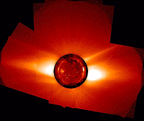 The Sun
The Sun The Sun
The SunThe Sun is also a variable star: enormous active regions of magnetic flux (with field strengths of up to 2000 - 3000 gauss, or 1000 times the earth's surface magnetic field strength) emerge from the convection zone onto the solar surface with a frequency that varies over a cycle lasting about 11 years. Associated with the magnetic active regions are a wide range of solar activity: sunspots, flares, faculae, plage, and so on. As the Suns rotates, differential rotation (the Sun, as a gaseous body, rotates at different rates at different latitudes) stretches out the active regions, and large-scale overturning motions below the solar surface push the remnants poleward. At high latitudes, the magnetic flux is submerged.
Above the active regions on the visible surface of the Sun, the magnetic fields extend far into the solar corona, the tenuous, outer atmosphere of the Sun seen normally only during total solar eclipses. Indeed, the structure of the solar atmosphere above the visible surface is dominated by magnetic fields.
Even the quiet Sun --- those parts of the sun's visible atmosphere without the more obvious signs of solar activity --- are threaded with magnetic fields. Coronal holes are regions of lower temperature than the surrounding corona, and are sources of high-speed streams in the solar wind, the extension of the Sun's atmosphere into interplanetary and interstellar space.
The study of the Sun is the foundation of all we know about the cosmos: the Sun is the reference for our study of all other stellar atmospheres and interiors, despite vast differences in size, energy generation rates, rotation speed, and magnetic activity; spectroscopy, which tells us about velocities, densities, and temperatures of distant objects, was devised to understand the solar spectrum; helioseismology, the study of solar surface oscillations that allows us to infer the physical conditions far below the visible surface of the Sun, has led to advances in the study of stellar oscillations; and the outer solar atmosphere is in effect a laboratory where we can observe in detail the magnetohydrodynamic processes that produce stellar winds, stellar flares, and galactic jets.
Among the outstanding problems of solar physics today that will tell us more about other stars, and perhaps about more basic physics as well, are: